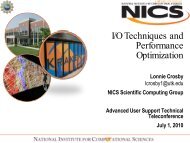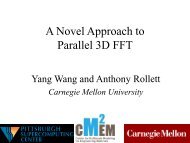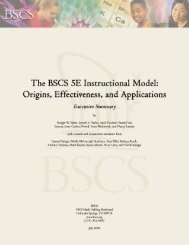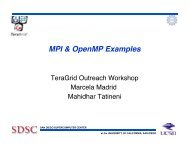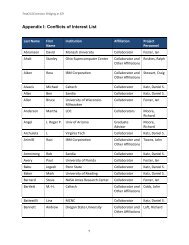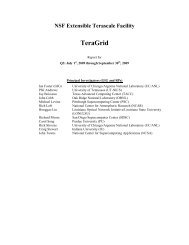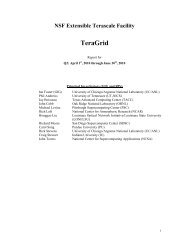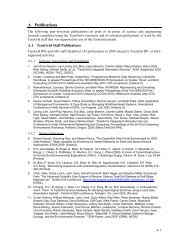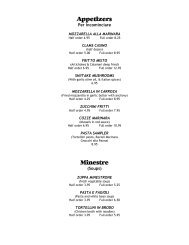TGQR 2010Q4 Report.pdf - Teragridforum.org
TGQR 2010Q4 Report.pdf - Teragridforum.org
TGQR 2010Q4 Report.pdf - Teragridforum.org
Create successful ePaper yourself
Turn your PDF publications into a flip-book with our unique Google optimized e-Paper software.
to the seafloor. Vortex shedding causes energy transfer from fluid to the structure and leads to<br />
high-amplitude vibrations that can trigger fatigue failure of the structural systems. These new<br />
methods will help accurately evaluate, both qualitatively as well as quantitatively, the fatigue<br />
failure phenomena that is triggered by the turbulence in the natural convective flows around<br />
risers, thus providing a clearer and a more precise picture when the failure can happen. This will<br />
help in taking preventive measure in time, and therefore will be important not only for the design<br />
of these components, but also as a method to monitor these deep sea oil pipelines in the Gulf of<br />
Mexico.<br />
To visualize the 3D nature of turbulent flows, the team turned to NCSA’s Advanced Applications<br />
Support visualization team. Visualization programmer Mark Van Moer used ParaView, a parallel<br />
renderer, with custom VTK scripts to create visualizations for the team. “These visualizations<br />
have tremendously benefited us in the method development phase,” says Masud.<br />
This work will be presented at the 16th International Conference on Finite Elements in Flow<br />
Problems, Munich, Germany, in March 2011.<br />
2.2.11<br />
Earth Sciences: A TeraGrid Community Climate System Modeling (CCSM) Portal (PI:<br />
Matthew Huber, Purdue)<br />
Graduate student Aaron Goldner used the<br />
TeraGrid Community Climate System<br />
Modeling Portal (developed at Purdue)<br />
and TeraGrid computational resources to<br />
show potential for wetter, rather than<br />
drier, conditions in the American<br />
Southwest (and, indeed, the entire<br />
American West and East) with projected<br />
climate change. The research, presented<br />
at the American Geophysical Union fall<br />
meeting in December 2010, offered<br />
another indicator of where current<br />
climate models can be refined. Goldner<br />
was able to use TeraGrid resources for<br />
the computationally demanding task of<br />
including tropical cyclone winds in his<br />
simulations. That yielded a different<br />
potential picture of future water cycles<br />
over North America than current<br />
modeling, which doesn’t include<br />
cyclonic winds and projects drought-like,<br />
rather than wetter, conditions in areas<br />
such as the American Southwest.<br />
The graphical user interface of the<br />
CCSM portal made it easier for Goldner<br />
to set up his modeling initially, while<br />
TeraGrid hardware enabled modeling at a<br />
level of detail that still required more<br />
than a month to complete. The CCSM<br />
portal also has been used in combined<br />
political science/earth and atmospheric<br />
sciences classes at Purdue. The goal is to<br />
Figure 2.11. Enhanced tropical cyclone activity within ocean models can<br />
produce feedbacks that affect El Niño cycles. When these changes in El<br />
Niño are used as boundary conditions within a global atmospheric 19 model<br />
they cause increased rainfall over the entire United States by shifting<br />
atmospheric circulation, thus altering hydrologic cycles.



